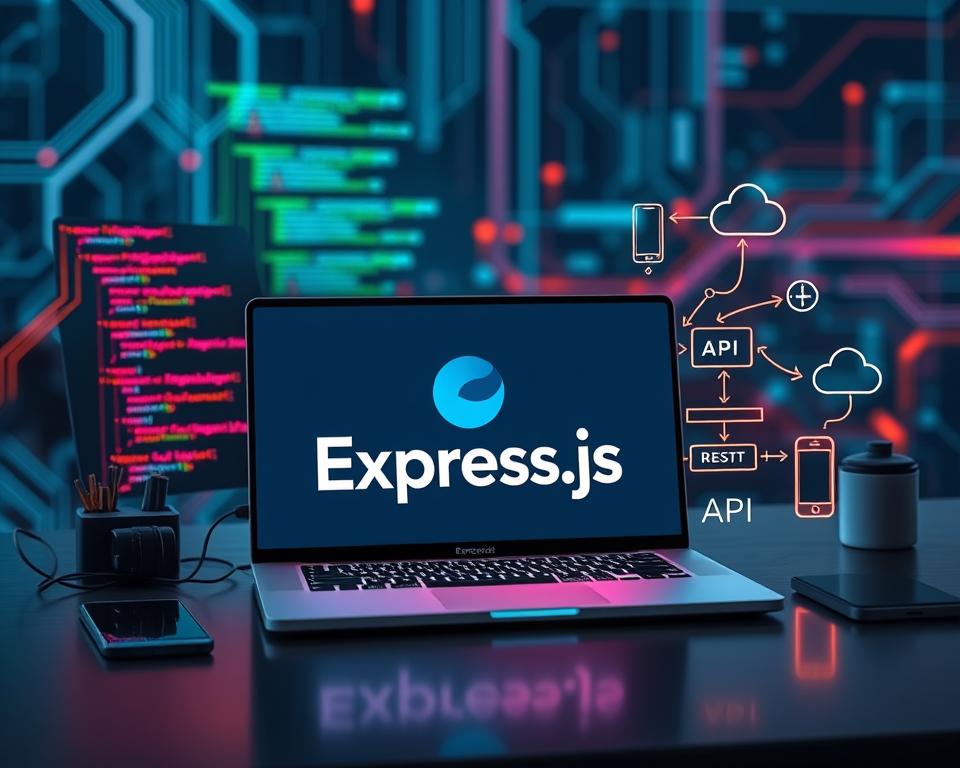The world of mobile app development is changing fast. Now, developers need tools that are both efficient and versatile. JavaScript has become a key player, working on both the frontend and backend of mobile apps. This language, once just for web browsers, now helps build full-stack mobile apps.
JavaScript makes it easier for developers to connect the client and server sides of mobile apps. This change has made mobile app development more efficient. Teams can work better together, thanks to JavaScript’s ability to simplify the development process.
Table of Contents
Key Takeaways
- JavaScript has evolved from a browser-based language to a versatile, full-stack solution for mobile app development.
- Using JavaScript across the frontend and backend of mobile apps enables improved efficiency and streamlined workflows.
- The JavaScript ecosystem offers a wide range of frameworks, libraries, and tools that cater to various mobile development needs.
- Node.js, React Native, and other JavaScript-powered technologies are revolutionizing the way mobile apps are built and deployed.
- Leveraging JavaScript’s capabilities allows developers to create high-performing, feature-rich mobile applications that deliver exceptional user experiences.
Understanding JavaScript’s Role in Full-Stack Mobile Development
JavaScript has grown from a web browser tool to a universal language. It now plays a key role in mobile app development. With full-stack JavaScript, developers can create apps with both frontend and backend parts. This makes app development faster and more efficient.
Evolution of JavaScript from Browser to Universal Language
Node.js was introduced in 2009, changing JavaScript’s role. It allowed JavaScript to be used for server-side tasks. This shift made JavaScript a universal language for various applications, including mobile apps.
Key Benefits of Using JavaScript Across the Stack
- Code Reuse: Developers can use the same code for both app parts, saving time and effort.
- Faster Development Cycles: Using one language for all parts of an app speeds up development.
- Talent Pool Expansion: JavaScript’s popularity has grown the number of skilled developers available for projects.
Modern JavaScript Ecosystem Overview
The JavaScript ecosystem has grown a lot. New frameworks and tools have been added for mobile app development. React Native, Ionic, and NativeScript are popular for cross-platform apps. Node.js and its NPM ecosystem handle the app’s backend.
By using full-stack JavaScript, mobile developers can make efficient and innovative apps. They can meet the changing needs of the market with JavaScript’s versatility and a strong ecosystem.
The Rise of JavaScript Frameworks for Mobile Development
In the world of mobile app development, JavaScript frameworks have changed the game. React Native, Angular, and Vue.js are now key players. They make app development faster and user experiences better.
React Native is a big hit, thanks to Facebook. It lets developers use JavaScript to create native apps. This makes it a top pick for many teams.
Angular is another big name in mobile development. Google backs it, and it’s great for web and mobile apps. It’s known for its strong architecture and testing tools.
Vue.js is quickly becoming popular too. It’s simple, flexible, and fast. Its design makes it great for mobile apps.
These frameworks have changed the mobile app world. They let developers use JavaScript for everything. This makes app development easier and more efficient.
The mobile app market is always changing. JavaScript frameworks are key for making apps that meet these changes. They help developers create apps that are both innovative and user-friendly.
Node.js: Powering the Backend of Mobile Applications
JavaScript is now key in mobile app development, moving from the front-end to the back-end. Node.js is a big reason for this change. It’s a runtime environment that lets developers use JavaScript for server-side tasks.
Server-Side JavaScript Capabilities
Node.js lets developers use JavaScript for the back-end. This makes it possible to build strong, scalable, and efficient backends for mobile apps. Its event-driven model is great for handling data-heavy, real-time apps.
Node.js Performance Benefits
Using Node.js for mobile app development offers great performance. It uses the V8 JavaScript engine for fast server-side code execution. This means less delay and better app response for users.
NPM Ecosystem Advantages
The Node.js backend also benefits from the NPM ecosystem. This ecosystem has a huge library of open-source packages. Developers can add many features to their backends easily, from security to data management.
| Feature | Node.js Benefit |
|---|---|
| Server-Side JavaScript | Allows developers to use a familiar language for both front-end and back-end development, streamlining the mobile app development process. |
| Performance | Leverages the powerful V8 JavaScript engine, resulting in faster execution of server-side code and improved responsiveness for mobile users. |
| NPM Ecosystem | Provides access to a vast library of open-source packages and modules, enabling seamless integration of various functionalities into the mobile backend. |
By using Node.js, developers can make the most of server-side JavaScript. They can create high-performance, feature-rich backends. These backends work well with the front-end of mobile apps.
React Native and JavaScript for Native Mobile Apps
React Native has changed the game in mobile development. It lets developers make native mobile apps with JavaScript. This framework has made cross-platform development easier, allowing for apps that look great on both iOS and Android.
React Native uses JavaScript to make apps feel native. It connects web and mobile development. This means apps built with React Native perform like native apps, offering a smooth experience.
The React Native ecosystem offers many tools and libraries. These help developers make apps that are fast and full of features. Apps built with React Native can match the quality of native apps.
“React Native has completely transformed the way we approach mobile development. It allows us to build native-quality apps using the language we love – JavaScript.“
The React Native community is growing fast. It has many open-source libraries and components. This makes it easier for developers to build and improve apps, making React Native a top choice for JavaScript mobile development.
In short, React Native and JavaScript have made a big impact on mobile development. They offer a flexible way to build native mobile apps. By using JavaScript and React Native, developers can create apps that work well on both web and mobile, giving users a great experience.
Express.js and REST API Development for Mobile Backend
The mobile app market is growing fast. Developers need ways to build strong backend solutions. Express.js is a top JavaScript framework for REST APIs in mobile backends. We’ll look at how Express.js helps build mobile-friendly backends, focusing on best practices, authentication, and database strategies.
API Architecture Best Practices
A good API architecture is key for your mobile app’s success. With Express.js, you can use standard best practices. This makes your REST API scalable, easy to maintain, and secure. Follow principles like versioning, resource-oriented design, and consistent responses.
Authentication and Security Implementation
Security is crucial for any mobile backend. Express.js offers strong tools for authentication and authorization. You can use JSON Web Tokens (JWT) or OAuth 2.0 to protect your app’s data and users.
Database Integration Strategies
Connecting to a database is vital for your mobile app’s backend. Express.js makes it easy to link to SQL and NoSQL databases. Learn how to manage data efficiently and scale your backend to meet growing user needs.
“Express.js has become the de facto standard for building REST APIs in the JavaScript ecosystem, making it a natural choice for powering the backend of mobile applications.”
Using Express.js, developers can build scalable, secure mobile backends. These backends work well with the frontend, giving users a smooth experience on all devices.
MongoDB and JavaScript: Creating a NoSQL Backend
In the world of mobile app development, a flexible database is crucial. MongoDB is a top NoSQL database that works well with JavaScript. It’s great for both the frontend and backend.
MongoDB is perfect for JavaScript-powered mobile apps because it handles unstructured data easily. Mobile apps deal with many types of data, like user profiles and multimedia. MongoDB’s flexible schema lets developers store and query this data well. This is better than traditional relational databases.
| Feature | Benefit |
|---|---|
| Dynamic Schema | Accommodates evolving data structures in mobile apps |
| High Scalability | Supports the growing data demands of mobile applications |
| Seamless Integration with Node.js | Enables a streamlined JavaScript backend for mobile apps |
Using MongoDB as the NoSQL database and Node.js for the JavaScript backend helps developers. They can build a strong and scalable mobile data storage solution. This lets apps meet the changing needs of users.
“MongoDB’s flexible schema and seamless integration with Node.js make it a powerful choice for building JavaScript-driven mobile backends.”
Real-Time Features with WebSockets and Socket.io
Mobile apps are getting better, and real-time features are key. WebSockets and Socket.io make it easy for apps to talk to each other in real-time. They change how data moves between apps and servers, making mobile experiences more interactive.
Implementing Push Notifications
WebSockets and Socket.io help with push notifications. They let apps send updates, alerts, and messages right away. This makes apps more engaging and personal for users.
Live Data Synchronization
These technologies also make data sharing live. Changes are seen instantly on all devices. This is great for apps where many people need to see the same data at the same time.
Using WebSockets and Socket.io, developers can create amazing real-time features. These features improve how users interact with apps. They make apps more responsive and connected than ever.
JavaScript Testing Strategies for Mobile Applications
JavaScript is becoming more popular in mobile app development. It’s important to make sure these apps work well and are reliable. Using strong testing strategies is key to creating top-notch, bug-free apps.
There are many JavaScript testing frameworks and automated testing methods. Let’s look at the best ways to test JavaScript-based mobile apps.
Unit Testing for JavaScript Mobile Apps
Unit testing is the base of a good testing plan for JavaScript mobile apps. Tools like Jest, Mocha, and Jasmine are great for checking app parts and functions. They help find bugs early, making sure your app’s core works right.
Automated UI and Integration Testing
Automated testing is also crucial for app quality and function. Cypress, Selenium, and Appium help run tests that mimic user actions. They check UI elements and make sure app parts work together well.
With a solid mobile app testing plan, you can improve your app’s reliability, performance, and user experience. This means you’ll give your customers a better product.
“Testing is not just about finding bugs, it’s about building confidence in the quality of your application.”
Performance Optimization Techniques for JavaScript Mobile Apps
Mobile apps are now a big part of our lives. JavaScript is key in making them work. To make apps fast and smooth, developers use special techniques.
Code Splitting and Lazy Loading
Code splitting breaks down the app’s code into smaller parts. This makes the app load faster by only using what’s needed. Adding lazy loading makes things even better by loading resources only when they’re needed.
Memory Management Best Practices
Mobile apps need to use memory wisely because devices have limited resources. Following best practices helps avoid memory issues. Using garbage collection and managing event listeners also helps keep apps running smoothly.
By using these techniques, developers can make mobile apps that are fast and fun to use. This keeps users coming back for more.
Debugging and Monitoring JavaScript Mobile Applications
Creating mobile apps with JavaScript has its own set of challenges. Developers face unique hurdles when debugging and monitoring. They need strong tools and strategies to keep their apps stable and fast.
Using JavaScript debugging tools is crucial. These tools help find and fix code problems, from small errors to big issues. Debuggers let developers see how their code works, helping them understand app behavior.
Performance monitoring is also key for a good user experience. Developers use tools to track important metrics like how fast the app loads and how smooth it runs. This helps them find and fix slow spots.
Keeping an eye on error tracking is vital too. With error reporting tools, developers can see what users are facing. This lets them quickly fix bugs and crashes.
“Debugging and monitoring are essential for ensuring the long-term success of any JavaScript-based mobile application. The right tools and strategies can make all the difference in delivering a seamless user experience.”
By using the best debugging tools, performance monitoring, and error tracking, developers can make sure their apps work well. This keeps users happy and coming back.
| Debugging Tool | Key Features | Supported Platforms |
|---|---|---|
| React Native Debugger | Integrated debugging, performance monitoring, and inspection tools for React Native apps | iOS, Android |
| NativeScript Inspector | Comprehensive debugging and inspection tools for NativeScript-based mobile apps | iOS, Android |
| Sentry | Advanced error tracking and reporting solution for JavaScript applications | iOS, Android, Web |
Security Considerations for Full-Stack JavaScript Apps
JavaScript is becoming more popular in mobile app development. This means we need to focus on mobile app security more than ever. Full-stack JavaScript apps, which use JavaScript for both the front and back ends, face special security challenges.
Common Security Vulnerabilities
JavaScript-based mobile apps can face many security threats. These include cross-site scripting (XSS), mobile app security breaches, and injection attacks. These threats can put user data at risk and harm the app’s integrity.
- Cross-site scripting (XSS) attacks: If user input isn’t properly cleaned, malicious scripts can run. This lets attackers get to user data.
- JavaScript security vulnerabilities: Weak JavaScript code or outdated libraries can create security holes.
- Injection attacks: If APIs or database interactions aren’t secure, attackers can inject bad code. This can let them get to sensitive info.
Implementation of Security Best Practices
To fight these security risks, we need a solid security plan for full-stack JavaScript mobile apps. This plan should include:
- Using strong input validation and output encoding to stop XSS attacks.
- Updating all JavaScript dependencies and libraries to fix known issues.
- Securing API endpoints and using strong login and access controls.
- Protecting user data with encryption and secure storage.
- Testing the app regularly for security flaws and fixing any found.
| Security Consideration | Best Practice |
|---|---|
| mobile app security | Implement robust input validation and output encoding |
| JavaScript security | Keep JavaScript dependencies and libraries up-to-date |
| vulnerability prevention | Secure API endpoints and implement strong authentication |
| data protection | Employ encryption and secure data storage measures |
By tackling these security issues and following best practices, developers can make full-stack JavaScript mobile apps safe. These apps will offer a secure experience for users.
“Proactive security measures are essential in today’s mobile app landscape, where the rise of full-stack JavaScript development has introduced new security challenges.”
Deployment Strategies for JavaScript Mobile Applications
JavaScript is now used in mobile app development, making deployment strategies key. Developers can deploy mobile apps smoothly and efficiently with JavaScript. This ensures a great user experience.
Continuous Integration: The Key to Streamlined Deployment
A strong continuous integration (CI) workflow is essential for mobile app deployment. It automates the build, test, and deployment process. This makes mobile app deployment reliable and quick.
It allows for fast updates and bug fixes. This keeps users happy with the latest app versions.
App Store Submission: Navigating the Approval Process
When submitting a JavaScript app to the app store, careful planning is needed. It’s important to follow the platform’s guidelines and requirements for a successful app store submission. Developers must prepare all necessary assets and metadata.
They also need to make sure the app meets the platform’s standards.
Over-the-Air Updates: Keeping Users Engaged
JavaScript’s ability to handle over-the-air updates is a big plus. It lets developers update the app without users having to do anything. This keeps the app fresh and secure.
By using JavaScript, developers can make deploying mobile apps easier. From continuous integration to app store submission and updates, it’s all about a smooth user experience. JavaScript keeps mobile apps at the top of user satisfaction.
Conclusion
JavaScript has become a key player in mobile app development. It’s not just for the web anymore. It’s now used for both the frontend and backend of apps.
Frameworks like React Native have made it easier to create mobile apps. They use web development skills, making it simpler. Node.js on the backend adds to this, offering a unified codebase and better performance.
The future of JavaScript in mobile apps looks bright. We’ll see more real-time features, better security, and improved performance. JavaScript’s flexibility will keep driving innovation, making it a top choice for developers and businesses.



















